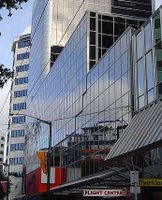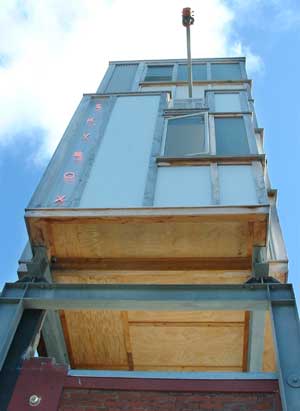Fouler
It's not surprising that architects don't always get along: stylistic debates can sometimes reach the intensity of religious wars, and the strength of personality required to see one's vision realised in millions of dollars' worth of concrete and steel is not always compatible with modesty and reticence. But it's a while since I've seen vitriol being flung about as publicly as in Sir Michael Fowler's review in the Dominion Post (April 15) of New Dreamland: Writing New Zealand Architecture, edited by Douglas Lloyd Jenkins.
The review was mainly enthusiastic, but Sir Michael devoted the last two paragraphs to excoriating Gerald Melling's contribution. A snippet in the latest issue of Architecture New Zealand (May/June 2006, p19), entitled "Professional Foul", sums it up nicely:
Mr Melling was described as a "sulky Liverpudlian", his contribution to New Dreamland was characterised as "predictably insulting and innacurate", and his rooftop dwelling in Egmont St was deemed to be a "ludicrous five-floor outhouse". Could it be that Sir Michael is a Man United fan?
 If we put aside football rivalry as a possible motive, what was it that Melling said that so enraged Sir Michael? Melling's article was the title chapter from his 1989 book The Mid-City Crisis and other stories, which took the former Mid City Centre between Willis and Manners streets as an exemplar of all that was wrong with Wellington corporate architecture in the 1980s. I'll quote at length from the article to give a flavour of Melling's opinions on that retail and cinema complex:
If we put aside football rivalry as a possible motive, what was it that Melling said that so enraged Sir Michael? Melling's article was the title chapter from his 1989 book The Mid-City Crisis and other stories, which took the former Mid City Centre between Willis and Manners streets as an exemplar of all that was wrong with Wellington corporate architecture in the 1980s. I'll quote at length from the article to give a flavour of Melling's opinions on that retail and cinema complex:The building is no worse (though certainly no better) than many others of its recent vintage except, perhaps, in the ultimate poverty of its pretensions. The development aspires to urbanity, but achieves the provincial; it searches for glitter, but finds only paste (the crude flash of glass rather than the subtle wink of gemstones); it attempts to be slick, but forgets oil begets dandruff; and in trying to shout it simply loses its voice.So, Melling doesn't exactly mince his words either, and perhaps he should be prepared for similar treatment. Is it "insulting"? Perhaps, though he doesn't mention the individual architects by name, so he refrains from the sort of personal abuse that Fowler strays into. Inaccurate? Wellingtonians who remember that particular labyrinth of crassness wouldn't think so. Bill Guthrie wrote in David Kernohan's book Wellington's New Buildings that "While the building may have some commercial merit there can be no doubt that if the glitzy image of Dallas or Miami is what Wellington seeks then higher levels of design quality and building finish are necessary to begin to approach the standards of the overseas models".
There is no discourse here with the city, no dialogue with the street - just a thin chessboard of glazing bars, a short neon script, a stubby verandah, and two yawning holes off the footpath. By day, the Mid City Centre is utterly comatose; by night it stretches into an anaemic form of occasionally misspelt neon life.
There is a disturbing and bewildering arrogance in the flippancy of this - that the building's designers (assuming a serious architectural intent) should consider their contribution to be enough, to be complete; that they should imagine a hole to be a whole; that they should expect a line drawing to be a building; and that they should anticipate architecture out of electric light alone.
So is Fowler's objection more personal? I don't think he was involved in the design of the Mid City Centre, but the lengths he goes to in defence of its architect suggests that this is more than a professional disagreement over aesthetics. Melling attacked the confusing circulation patterns of the centre, and Fowler responds by saying that "Sandy Geddes was a very competent architect handling a complicated brief on a sloping site - and handled that responsibility with a great deal more professional skill than Melling and his ludicrous five-floor outhouse at 26 Egmont St".
 So, Sir Michael gets his own back by insulting the Skybox, which is Melling's home as well as one of his most celebrated projects. "Ludicrous" and "outhouse" are obviously calculated insults, and "five-floor" is inaccurate (it has three storeys), so Fowler opens himself up to the same accusations that he made of Melling. Melling's urban work is clearly not to everyone's taste (as the debate over the Left Bank proves), but while his firm Melling:Morse has been seriously engaging with important issues such as exploring local traditions, using recycled materials and creating new typologies for urban living, Sir Michael has recently contributed to the advancement of New Zealand architecture by, erm, building a pseudo-Tuscan winery in Marlborough.
So, Sir Michael gets his own back by insulting the Skybox, which is Melling's home as well as one of his most celebrated projects. "Ludicrous" and "outhouse" are obviously calculated insults, and "five-floor" is inaccurate (it has three storeys), so Fowler opens himself up to the same accusations that he made of Melling. Melling's urban work is clearly not to everyone's taste (as the debate over the Left Bank proves), but while his firm Melling:Morse has been seriously engaging with important issues such as exploring local traditions, using recycled materials and creating new typologies for urban living, Sir Michael has recently contributed to the advancement of New Zealand architecture by, erm, building a pseudo-Tuscan winery in Marlborough. Meanwhile, the contentious Mid City Centre is no more. It's been thoroughly gutted, and is well on its way to becoming the new home of the Department of Conservation. Those behind the redevelopment (not Melling!) claim that it will be as much a symbol of inner-city green building as its predecessor was of 80s tackiness. The emerging Manners St elevation, while hardly exciting at the moment, at least has the environmental benefits of a double façade, as well as ditching the cheesy neon and mirror glass. It's true that an office complex is a much more straightforward programme than a multiplex cinema, but from the floor plans it looks like the circulation issues and street relationships demanded by the L-shaped site might be much better resolved than in its previous incarnation. And I look forward to seeing how the roof garden and atrium work out.
Meanwhile, the contentious Mid City Centre is no more. It's been thoroughly gutted, and is well on its way to becoming the new home of the Department of Conservation. Those behind the redevelopment (not Melling!) claim that it will be as much a symbol of inner-city green building as its predecessor was of 80s tackiness. The emerging Manners St elevation, while hardly exciting at the moment, at least has the environmental benefits of a double façade, as well as ditching the cheesy neon and mirror glass. It's true that an office complex is a much more straightforward programme than a multiplex cinema, but from the floor plans it looks like the circulation issues and street relationships demanded by the L-shaped site might be much better resolved than in its previous incarnation. And I look forward to seeing how the roof garden and atrium work out.



0 Comments:
Post a Comment
<< Home